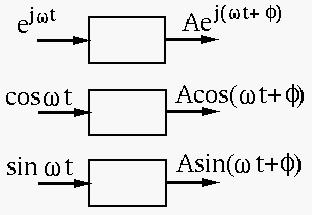RC circuit:
When the input to the system represented by the term on the right-hand
side of the DE is non-zero, the DE can be solved to find its particular
or steady state solution. We first a constant input:
 |
(84) |
With a constant input, the particular solution  must be constant
as well, and the DE becomes
must be constant
as well, and the DE becomes  , i.e., the solution is trivially
, i.e., the solution is trivially
 |
(85) |
We next consider a sinusoidal input
 . We first assume
the input is a complex exponential input:
. We first assume
the input is a complex exponential input:
 |
(86) |
and assume
 |
(87) |
and substitute them back into the DE to get
 |
(88) |
Solving for  we ge
we ge
 where where |
(89) |
and the solution is:
 |
(90) |
As the system is linear therefore superposition applies, we
can find the output corrresponding to a sinusoidal input
 , by taking the real part
of the solution above:
, by taking the real part
of the solution above:
![$\displaystyle v_C(t)=Re\left[\frac{1}{\sqrt{\omega^2 \tau^2+1}} e^{j(\omega t-\phi)}\right]
=\frac{1}{\sqrt{\omega^2 \tau^2+1}} \cos(\omega t-\phi)$](img290.svg) |
(91) |
Alternatively, this RC circuit can also be solved more conveniently by
the phasor method, if only the steady state solution (the particular
solution) is of interest. The phasor of the input voltage
 is simply 1, and the phasor of the voltage across
is simply 1, and the phasor of the voltage across
 can be found by voltage divider:
can be found by voltage divider:
 |
(92) |
where
 . Converting this phasor to time
function we get
. Converting this phasor to time
function we get
![$\displaystyle v_C(t)=Re[V_Ce^{j\omega t}]
=Re\left[\frac{1}{\sqrt{\omega^2\tau^...
...{j(\omega t-\phi)}\right]
=\frac{1}{\sqrt{\omega^2\tau^2+1}}\cos(\omega t-\phi)$](img294.svg) |
(93) |

 must be constant
as well, and the DE becomes
must be constant
as well, and the DE becomes  , i.e., the solution is trivially
, i.e., the solution is trivially




 we ge
we ge
 where
where

 , by taking the real part
of the solution above:
, by taking the real part
of the solution above:
![$\displaystyle v_C(t)=Re\left[\frac{1}{\sqrt{\omega^2 \tau^2+1}} e^{j(\omega t-\phi)}\right]
=\frac{1}{\sqrt{\omega^2 \tau^2+1}} \cos(\omega t-\phi)$](img290.svg)



 . Converting this phasor to time
function we get
. Converting this phasor to time
function we get
![$\displaystyle v_C(t)=Re[V_Ce^{j\omega t}]
=Re\left[\frac{1}{\sqrt{\omega^2\tau^...
...{j(\omega t-\phi)}\right]
=\frac{1}{\sqrt{\omega^2\tau^2+1}}\cos(\omega t-\phi)$](img294.svg)






 where
where

 is
is
![$\displaystyle i(t)=Re\left[\frac{1}{\sqrt{R^2+\omega^2 L^2}} e^{j(\omega t-\phi)}\right]
=\frac{1}{\sqrt{R^2+\omega^2 L^2}} \cos(\omega t-\phi)$](img303.svg)



 . By generalized Ohm's law,
the phasor representation of the current can be found as
. By generalized Ohm's law,
the phasor representation of the current can be found as

![$\displaystyle i(t)=Re\left[\frac{1}{\sqrt{R^2+\omega^2 L^2}}e^{-j\phi)}e^{j\omega t}\right]
=\frac{1}{\sqrt{R^2+\omega^2 L^2}}\cos(\omega t-\phi)$](img307.svg)



